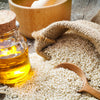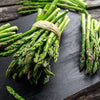“Ancient” wisdom revealed: the 3 best ancient grains for your health

Ancient grains have been “on the menu” and providing vital nourishment for humans for over 6,000 years. But what distinguishes them from other grains? The Whole Grains Council defines ancient grains as “grains that have been grown in the same manner for many centuries,” but this simple description doesn’t capture their many virtues.
Unlike processed grains such as refined white rice, whole grains retain their nutrient-laden hulls - giving them a nutritional “edge” over processed grains. In addition, they have not been genetically modified and are gluten-free - two big “pluses” for many consumers.
Let’s look at a trio of these time-honored whole grains and explore why they richly deserve to be included in a modern-day diet.
Quinoa delivers a jackpot of vitamins and minerals
One cup of cooked quinoa has eight grams of plant-based protein, five grams of fiber, and a whopping 50 percent of the adult recommended dietary intake for manganese, a mineral essential for brain health. It also delivers a third of the RDI for magnesium, which helps to regulate blood pressure, and 20 percent of the RDI for zinc, vital for immune system function. Quinoa doesn’t skimp when it comes to serving up the vitamins - the same cup contains 20 percent of the day’s folate, believed to protect against strokes, along with healthy amounts of vitamin B6 and antioxidant vitamin E. At a reasonable 222 calories per cup, quinoa is a nutritional bargain. And there’s more! High levels of fiber mean that quinoa is digested slowly, helping to stabilize blood sugar and creating a feeling of satiety or fullness.
In one 2020 study published in the European Journal of Nutrition, participants who ate half an ounce of quinoa flour biscuits a day for four weeks significantly lowered LDL cholesterol and body weight compared to those who ate wheat-based biscuits. By the way, quinoa is technically not a grain but a seed-like fruit classified as a pseudocereal. No matter how it’s classified, this hearty food is a good nutritional bet that can help promote a healthy weight.
Teff: Small but mighty
If you haven’t heard of teff, it’s likely that you soon will - this tiny grain is gaining popularity in the United States as a superfood. Teff, a significant food source in eastern Africa, delivers a fantastic array of nutrients, including eight essential amino acids and generous amounts of calcium, copper, and iron. Regarding protein content, teff is the “high-ringer” of the ancient grains, with a three-ounce serving containing an impressive 13 grams. The same serving of teff contains eight grams of dietary fiber, which speeds up the elimination of waste and helps to prevent constipation.
In addition, fiber is believed to promote healthy cholesterol levels while supporting gut health and lowering the odds of developing colon cancer. And because it is rich in phosphorus and magnesium, teff is believed to help alleviate painful periods and menstrual discomfort. At 367 calories per three-and-a-half-ounce serving, teff is not the lowest-calorie ancient grain on the shelf. But its high levels of protein, fiber, and micronutrients make it a satisfying, nutritious choice.
Anti-inflammatory amaranth is mineral-rich
Amaranth, a staple food in the ancient Incan, Mayan and Aztec civilizations, boasts a stellar nutritional profile that makes it just as desirable today. Like quinoa and teff, it is a good source of plant-based protein and fiber. It also delivers healthy amounts of bone-building magnesium and phosphorus, along with selenium, copper, and iron. Most notable is its manganese content, with a one-cup serving of cooked amaranth yielding a stunning 105 percent of the RDI for the entire day. Studies suggest that manganese can help prevent certain neurological conditions, making amaranth a brain-protective food.
In addition, research indicates that amaranth can help promote healthy cholesterol levels, as well as help reduce inflammation and oxidative damage. In one promising animal study, amaranth helped protect the liver from alcohol while increasing antioxidant status. Cutting-edge scientific analysis is revealing the merits of this ancient fare.
Versatile ancient grains are easy additions to the menu
Quinoa and amaranth contain compounds known as anti-nutrients, which can bind to iron and magnesium and reduce their absorption. Rinsing quinoa for a few minutes can help reduce the anti-nutrient content, allowing the grain’s nutty, delicate taste to shine through, and making it easier for your body to benefit from those critical minerals. (When it comes to amaranth, natural health experts advise sprouting it by soaking it for one to three days. With teff, you can skip the soaking entirely).
After rinsing or soaking, cooking ancient grains is a breeze. Simply use water and grain in a 3-to-1 ratio, bring to a boil, and simmer for 20 to 30 minutes until the water is absorbed.
Because of their mild, nutty taste and pleasing consistency, it’s easy to incorporate ancient grains into meals. Use them as a base for a cold, refreshing summer salad topped with feta cheese and cooked chicken or shrimp. You can also employ them as an alternative to meat in soups, sauces, stews, and chili. Try preparing them with roasted vegetables as a tasty side dish or serve them hot - as you would oatmeal or cream of wheat - topped with fruits, nuts, honey, and cinnamon.
Why not take advantage of the “wisdom of the ages?” Maybe it’s time to add quinoa, teff, and amaranth to your healthy contemporary diet.
Sources for this article include:
-
Posted in
amaranth, benefits of ancient grains, minerals, quinoa, teff, whole grains






